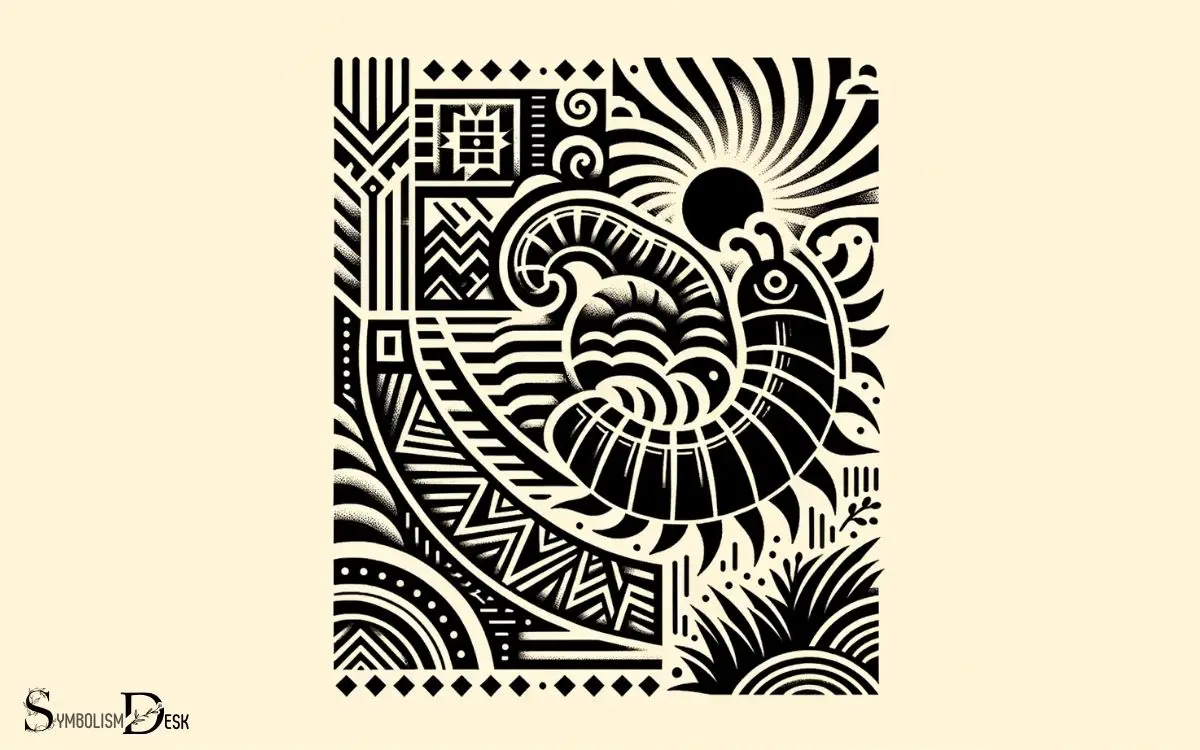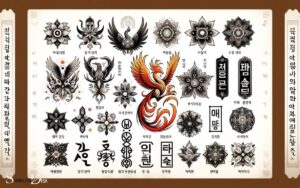Kalinga Tattoo Symbols and Meanings: Batok!
Kalinga tattoos, known as ‘batok,’ hold a sacred place in the culture of the Kalinga people in the Philippines.
These tattoos are revered for their intricate designs and profound meanings, each symbol representing elements of nature, tribal identity, valor, and individual achievements.
The Kalinga tribe has a storied history of tattooing, where warriors earned tattoos through acts of bravery, while women adorned them for beauty or to signify milestones.
Common symbols include:
Centipedes (gayaman):
- Symbolizing protection and strength.
- Rice bundles: Representing prosperity and abundance.
Python scales (sinag): Indicating stealth and speed.
Each Kalinga tattoo is a visual narrative of personal and tribal history, etched onto the skin as a permanent testament to one’s life and legacy.

Key Takeaway
Origins of Kalinga Tattooing
The origins of Kalinga tattooing date back to ancient indigenous practices and cultural beliefs.
For centuries, the Kalinga people of the Philippines have viewed tattooing as a sacred and spiritual tradition. Tattoos weren’t only ornamental but served as symbols of bravery, beauty, and social status. These intricate designs, often inspired by nature and geometric patterns, were deeply tied to the wearer’s identity and life experiences. Filipino tribal tattoo meanings varied, with some representing victories in battle, rites of passage, or protection from harm. Passed down through generations, these markings remain a testament to the rich cultural heritage of the Kalinga and other indigenous groups in the Philippines.
The indigenous practice of tattooing was deeply intertwined with the Kalinga people’s belief in the afterlife, protection from malevolent spirits, and the preservation of their cultural identity.
The process of tattooing, using thorns and soot, was a rite of passage for both men and women, symbolizing strength, courage, and the ability to endure pain.
This ancient practice continues to be a revered part of Kalinga culture, reflecting their rich history and spiritual significance.
Traditional Kalinga Tattoo Designs
Centuries-old Kalinga tattoo designs, each with its own symbolic significance, reflect the deeply rooted cultural beliefs and spiritual traditions of the indigenous community. The designs are intricate and often tell the story of the wearer’s tribe, status, and accomplishments.
Traditional Kalinga tattoo designs include geometric patterns, fern and ladder motifs, and representations of the sun, rice terraces, or centipedes.
These symbols hold deep meaning within the Kalinga culture, representing concepts such as bravery, protection, fertility, and unity.
The designs are hand-tapped into the skin using thorns and soot, a process that has been passed down through generations. Each tattoo is unique to the individual and serves as a visual representation of their personal and cultural identity.
Understanding the significance of these traditional designs provides insight into the rich heritage of the Kalinga people.
Symbolism in Kalinga Tattoos
Kalinga tattoo symbols convey profound cultural significance through intricate designs that reflect the wearer’s tribal identity and spiritual beliefs. Each symbol holds a specific meaning, often rooted in the tribe’s history, traditions, and connection to nature.
The centipede symbolizes protection and agility, while the python represents strength and power. The fern symbolizes growth and resilience, reflecting the wearer’s ability to overcome challenges.
The ladder symbolizes the journey to higher realms of existence and enlightenment. The rice grain design signifies abundance and prosperity, essential elements in the Kalinga way of life.
These symbols aren’t merely decorative; they’re a visual language that communicates the wearer’s values, experiences, and aspirations.
Understanding the symbolism behind Kalinga tattoos provides insight into the rich cultural tapestry of the Kalinga people.
Spiritual Significance of Kalinga Tattoos
Rooted in the spiritual beliefs of the Kalinga tribe, these tattoos embody the wearer’s connection to higher realms of existence and enlightenment.
Each symbol etched onto the skin holds profound spiritual significance, serving as a conduit for the individual’s spiritual journey.
The intricate designs are not merely decorative, but rather, they are sacred imprints that represent the wearer’s connection to the divine and their place within the universe.
The following table highlights some common Kalinga tattoo symbols and their spiritual meanings:
| Symbol | Meaning |
|---|---|
| Python | Wisdom, protection, and healing |
| Centipede | Strength and agility |
| Scorpion | Courage and protection |
These tattoos are not only a form of personal expression but also a tangible representation of the wearer’s spiritual beliefs and aspirations.
Preservation of Kalinga Tattoo Culture
The preservation of Kalinga tattoo culture reflects the tribe’s commitment to safeguarding their spiritual heritage and maintaining the integrity of their sacred tattooing practices.
In an effort to ensure the continuity of this ancient tradition, the Kalinga community has taken proactive measures to pass down the art of tattooing from one generation to the next.
Elders play a crucial role in teaching the significance of the symbols, as well as the techniques involved in the tattooing process.
Additionally, there are ongoing efforts to document the meanings and stories behind the symbols, as well as the rituals associated with the tattooing ceremonies.
Conclusion
The ancient art of Kalinga tattooing is a living testament to the rich cultural heritage of the Philippines.
The intricate designs and powerful symbolism of Kalinga tattoos tell stories of bravery, strength, and spirituality.
As the tradition continues to be passed down through generations, the vibrant images of warriors and nature come to life on the skin, creating a powerful connection to the past and a bridge to the future.






